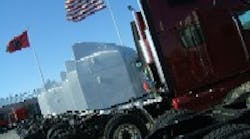"Listen to the wind blow/watch the sun rise. Listen to the wind blow/down comes the night." --Fleetwood Mac
So it's official now, with the numbers before us in firm, inescapable, black-and-white reality. The truck sales falloff in 2007 proved to be as bad as everyone thought it would be -- a nearly 47% drop in Class 8 sales, echoed by a 22.7% decline in Class 6 & 7 sales, as tracked by our sister company, Ward's AutoInfoBank.
In raw numbers, Class 8 sales overall dropped by an astounding 133,043 units in the space of one year, with Class 6 & 7 sales contracting by 36,608 units. True, much of the record 284,008 sales in Class 8 units back in '06 are still sitting along the fences of many a trucking company, as they pre-bought rolling stock to stay ahead of mandated changes to emission control technology on highway tractors -- changes that boosted sticker prices by upwards of $10,000 per unit. But that is still one heck of a knock to take in terms of lower annual production volume. And it's not exepcted to improve anytime soon.
"Class 8 industry retail sales in the U.S. and Canada in 2007 ... reflected the impact of the 2006 ‘pre-buy‘ as well as the slowdown in the housing and automotive sectors," said Dan Sobic, senior vice president at Paccar, which builds Peterbilt and Kenworth trucks in the U.S. plus DAF trucks in Europe. "Industry retail sales in 2008 are expected to be in the range of 175,000 to 215,000 vehicles, reflecting continued economic softness through the first half of the year."
By all acounts, now, OEMs are expecting a similar spike-and-fall when we get to the 2009 and 2010 sales years, when the final stage of emission control regulations go into effect. As with the 2007 mandates, increases in base sticker prices are most likely in the cards -- though just how much those increases will be is open to debate.
Some truck and engine makers -- notably International and Cummins -- have openly stated they are NOT going to use selective catalytic reduction (SCR) technology to make their heavy-duty engine platforms comply with the regulations, instead using credits they will 'bank' from the addition of SCR to their smaller displacement engines. That could substiantly reduce the premium for International's 2010-compliant heavy-duty trucks as well as those equipped with Cummins' engines ... or it may not. It's too early to tell what the fiscal impact of their technology path will be.
Either way you look at it, though, we've got another yo-yo cycle ahead for truck sales. And if it's anything like this last one, it'll be one heck of roller coaster ride for everyone.




